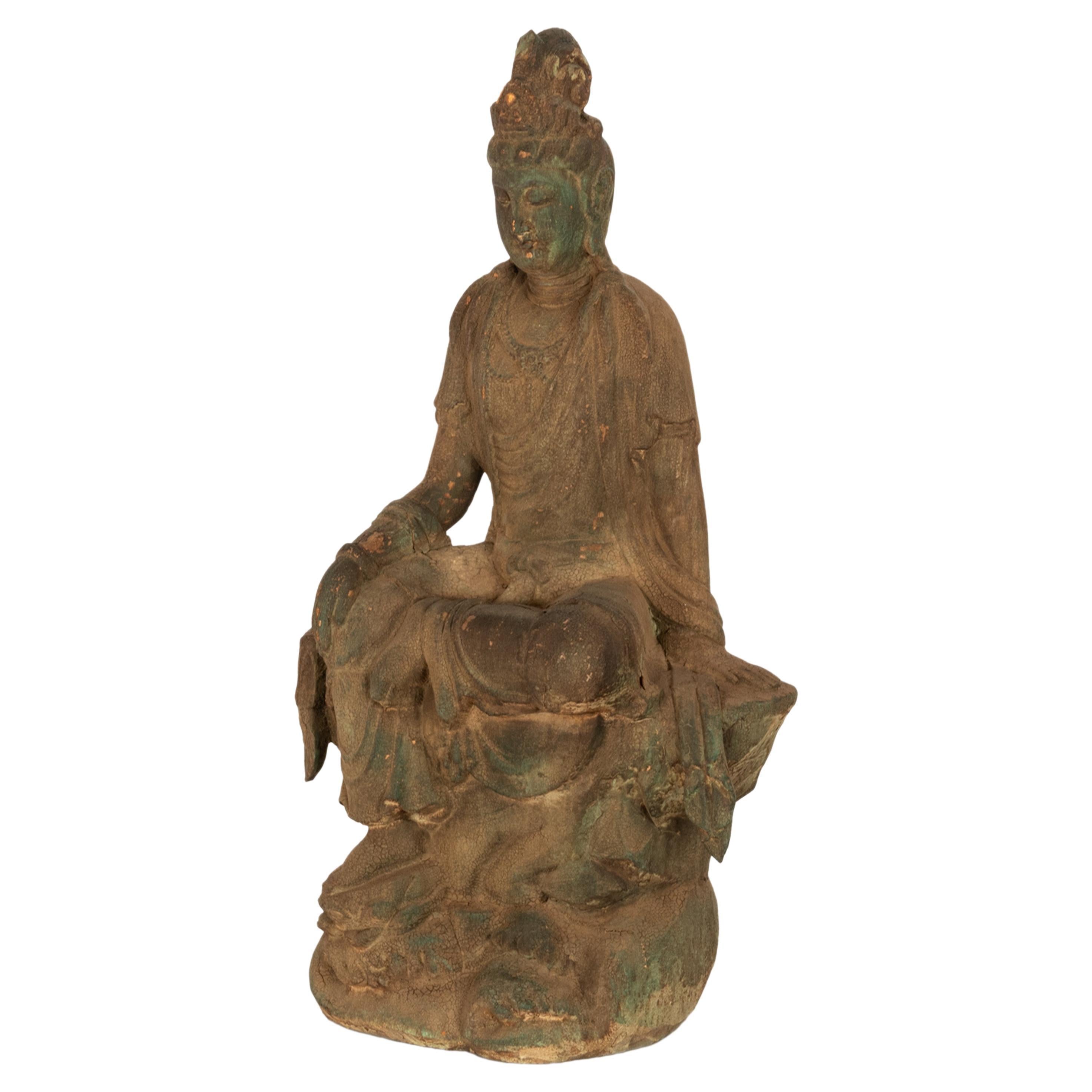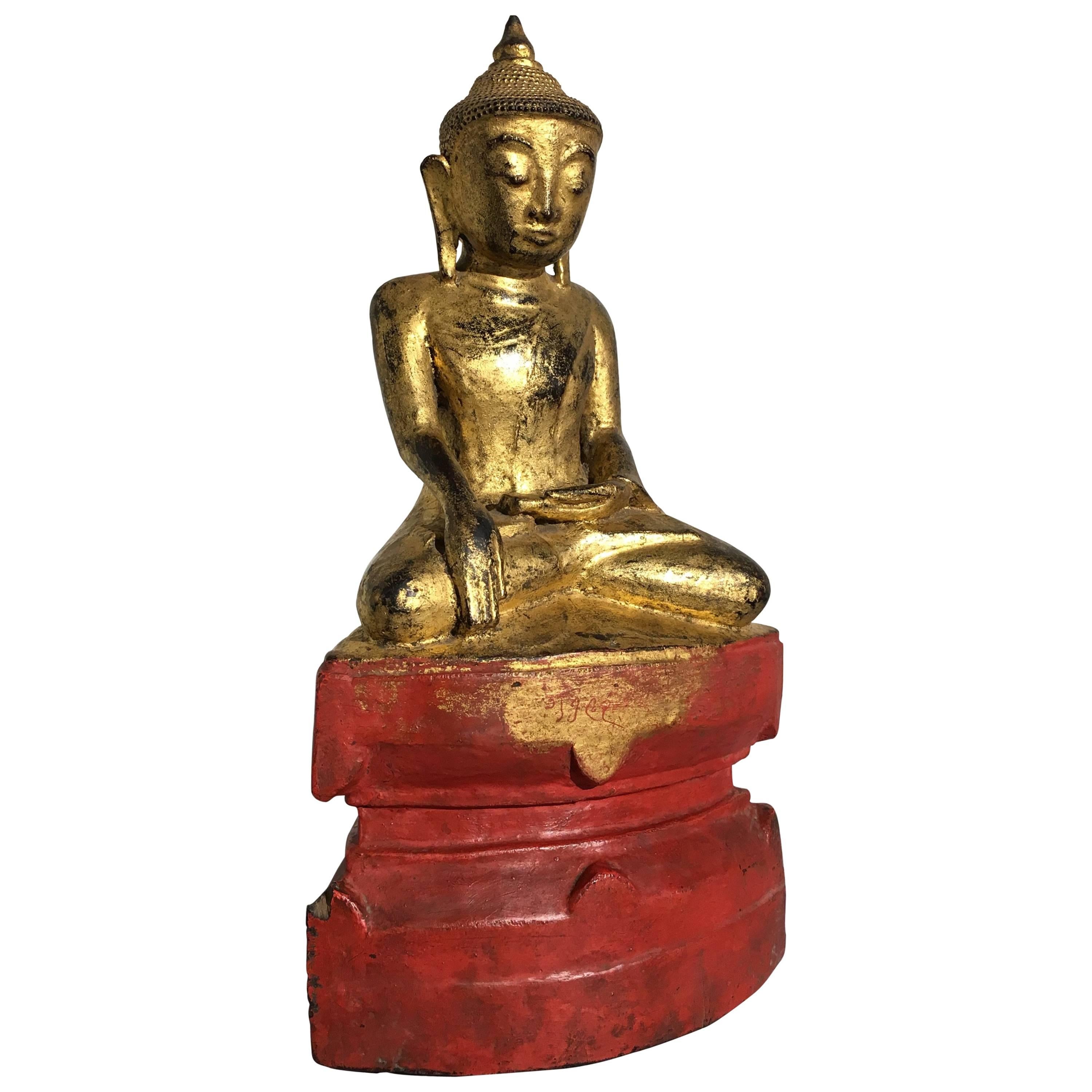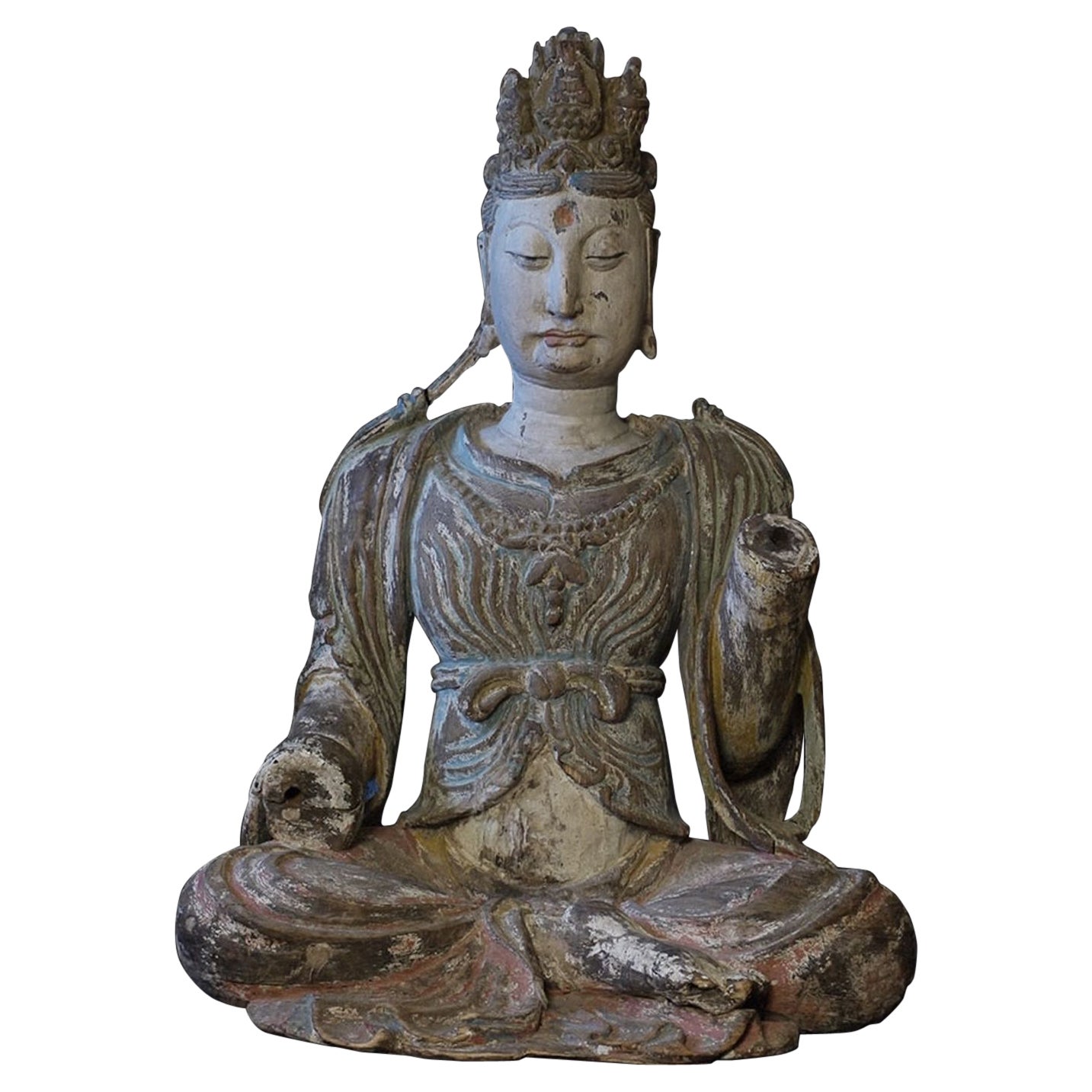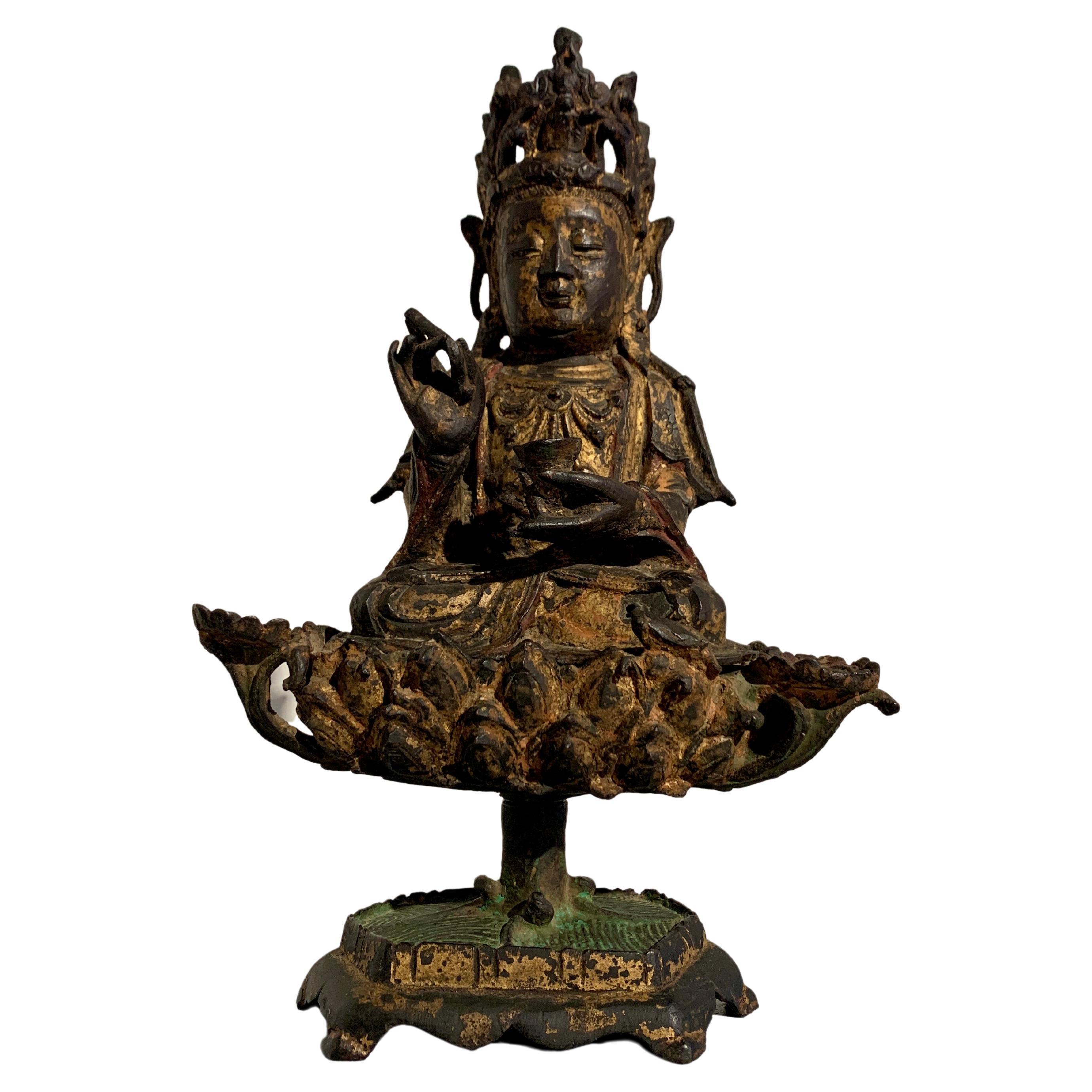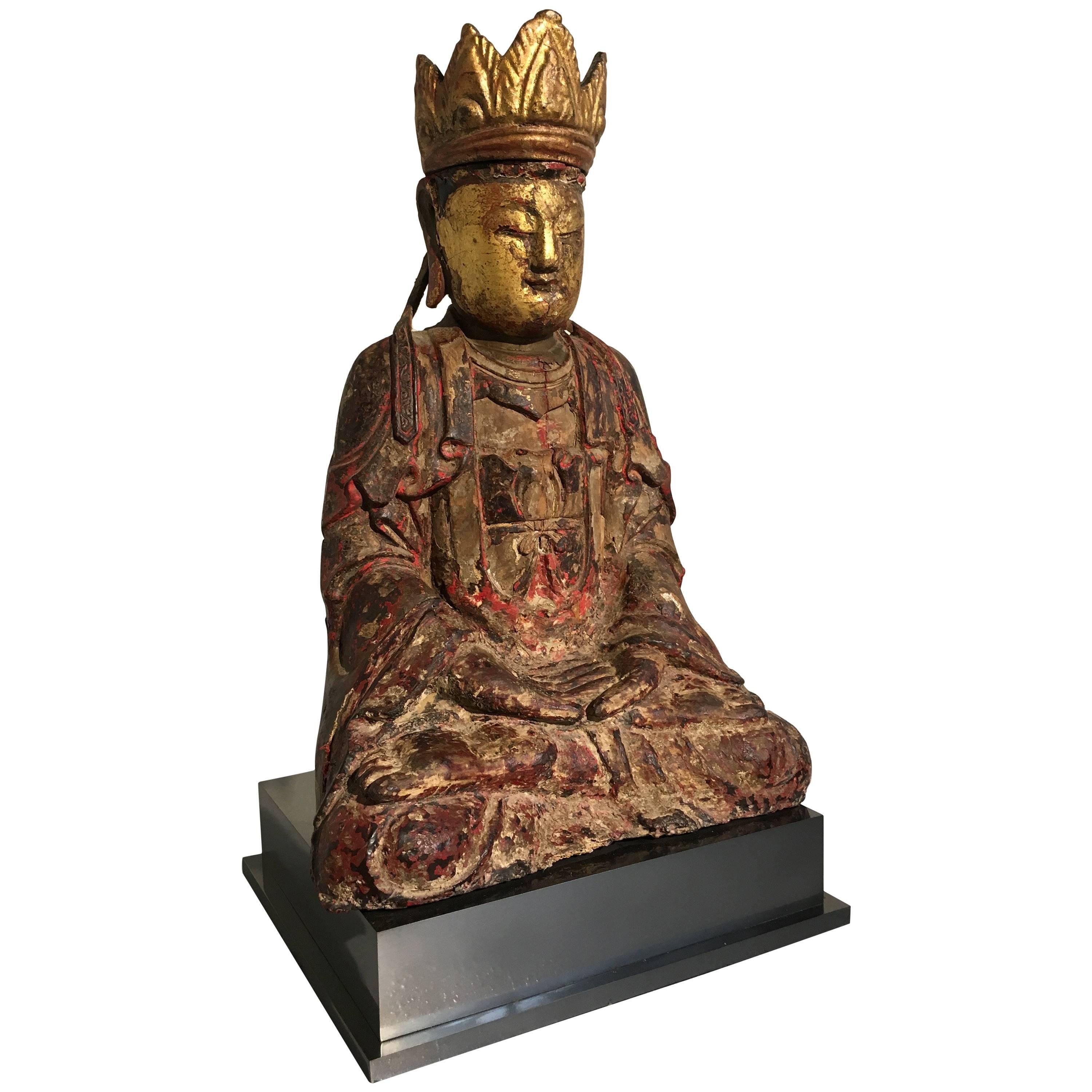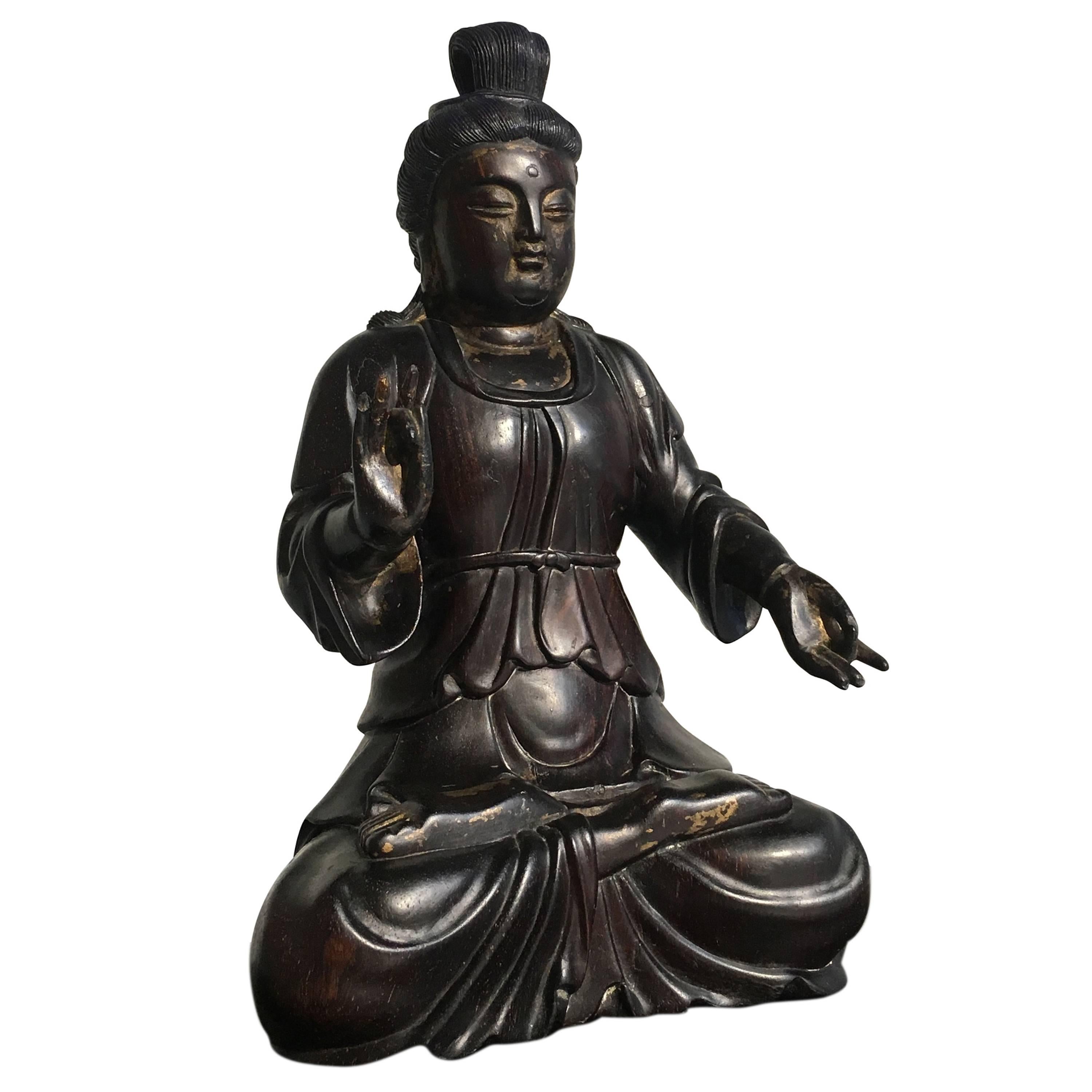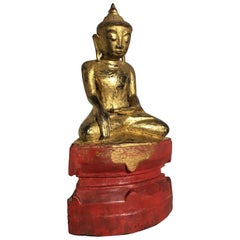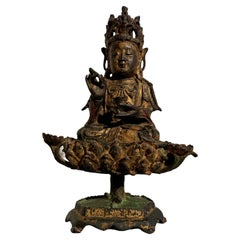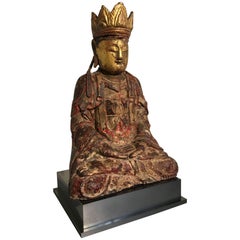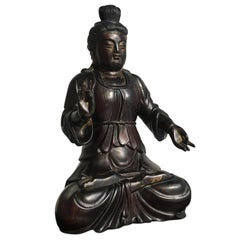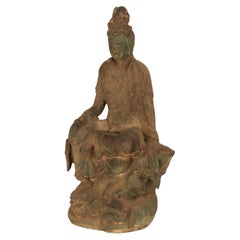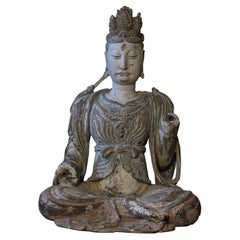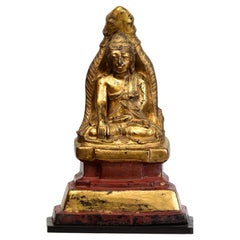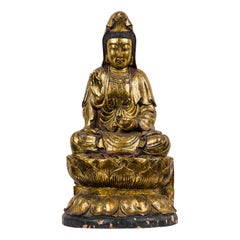Items Similar to Chinese Ming Dynasty Lacquered and Gilt Bronze Bodhisattva, 17th Century
Want more images or videos?
Request additional images or videos from the seller
1 of 11
Chinese Ming Dynasty Lacquered and Gilt Bronze Bodhisattva, 17th Century
$6,500
£4,913.19
€5,646.13
CA$9,051.21
A$10,069.10
CHF 5,278.35
MX$123,041.95
NOK 67,213.18
SEK 63,271.91
DKK 42,146.25
Shipping
Retrieving quote...The 1stDibs Promise:
Authenticity Guarantee,
Money-Back Guarantee,
24-Hour Cancellation
About the Item
Chinese late Ming dynasty bronze figure of the Bodhisattva Avalokiteshvara, also known as Guanyin (Quan Yin, Kwan Yin, Kuan Yin), 17th century, China
The figure well cast in two parts, with remnants of rich lacquer and gilding throughout, much of it preserved on the face.
The Bodhisattva of Compassion sits upon a separately cast lotus pedestal, a warm and benevolent expression on his face. He is dressed in voluminous robes and festooned with jewels. An elaborate diadem graces his head, with an image of Amitabha Buddha at the center. A cup raised to chest level in one hand, the other hand in abhaya mudra, the gesture of protection and reassurance.
- Dimensions:Height: 11.5 in (29.21 cm)Width: 6.25 in (15.88 cm)Depth: 4.25 in (10.8 cm)
- Style:Ming (Of the Period)
- Materials and Techniques:
- Place of Origin:
- Period:Mid-17th Century
- Date of Manufacture:Mid-17th Century
- Condition:Wear consistent with age and use. Minor losses. Minor structural damages. Minor fading. Much of the lacquer and gilding worn. The figure with loss to the robe at the front. Also with a crack and minor loss to the back. Please see photos.
- Seller Location:Austin, TX
- Reference Number:1stDibs: LU894718156682
About the Seller
5.0
Platinum Seller
Premium sellers with a 4.7+ rating and 24-hour response times
Established in 2001
1stDibs seller since 2010
345 sales on 1stDibs
Typical response time: <1 hour
- ShippingRetrieving quote...Shipping from: Austin, TX
- Return Policy
Authenticity Guarantee
In the unlikely event there’s an issue with an item’s authenticity, contact us within 1 year for a full refund. DetailsMoney-Back Guarantee
If your item is not as described, is damaged in transit, or does not arrive, contact us within 7 days for a full refund. Details24-Hour Cancellation
You have a 24-hour grace period in which to reconsider your purchase, with no questions asked.Vetted Professional Sellers
Our world-class sellers must adhere to strict standards for service and quality, maintaining the integrity of our listings.Price-Match Guarantee
If you find that a seller listed the same item for a lower price elsewhere, we’ll match it.Trusted Global Delivery
Our best-in-class carrier network provides specialized shipping options worldwide, including custom delivery.More From This Seller
View AllShan Burmese Lacquered and Gilt Wood Buddha, Ava Period, 18th Century
Located in Austin, TX
A rare and exquisite 18th century Ava period Shan Burmese figure of the Buddha.
Carved from a single block of wood, lacquered and gilt, the immensely s...
Category
Antique Mid-18th Century Burmese Sculptures and Carvings
Materials
Teak
Chinese Ming Dynasty Bronze Nanhai Guanyin, 16th/17th Century, China
Located in Austin, TX
A decidingly charming Chinese polychromed and gilt cast bronze figure of Nanhai Guanyin, Guanyin of the South Sea, Ming Dynasty, 16th/17th century, China.
Guanyin, the bodhisattva of compassion, is portrayed here as a beatific figure seated upon a raised lotus pedestal over waves. Guanyin is dressed in heavy robes, and wears an elaborate headdress. The small figure of Amitabha Buddha in the headdress positively identifies this figure as Guanyin.
Guanyin rests one hand in his lap, holding a cup of pure water said to be able to alleviate all suffering. His other hand is raised, holding a willow branch which is used to sprinkle the healing waters.
The two lotus blossoms to either side of Guanyin would originally have supported figures of the acolytes...
Category
Antique Early 1600s Chinese Ming Sculptures and Carvings
Materials
Bronze
Chinese Ming Dynasty Carved, Painted and Giltwood Amitayus Buddha
Located in Austin, TX
A beautiful and serene Chinese Ming dynasty carved wood figure of the Buddha Amitayus, the Buddha of long life, and a form of Amitabha Buddha. He is seated in dhyanassana, dressed in...
Category
Antique 17th Century Chinese Ming Sculptures and Carvings
Materials
Wood
Chinese Carved Zitan Figure of a Bodhisattva, Qing Dynasty
Located in Austin, TX
A finely carved Chinese zitan wood figure of an unidentified bodhisattva, possibly Guanyin, late Qing Dynasty, circa 1900, China.
The androgynous figure has a plump, almost matronly face, with downcast eyes and a gentle smile. The hair in long tresses, gathered and tied in a high chignon.
The enlightened being is portrayed seated in dhyanasana, bare feet resting on crossed legs, both soles pointing up.
Thick robes billow and drape around the full figured body. The hands display...
Category
Early 20th Century Chinese Qing Sculptures and Carvings
Materials
Lapis Lazuli
Chinese Qing Dynasty Lacquered Wood Guanyin, 18th Century, Southern China
Located in Austin, TX
A Chinese early Qing Dynasty carved and lacquered wood figure of Guanyin, Southern China, 17th/18th century.
Guanyin, the Bodhisattva of Compassion and Mercy, is portrayed seated in dhyanasana, one hand raised in viktara mudra, the gesture of teaching and discourse.
The great bodhisattva is dressed in heavy, loose robes tied at the chest, with a mantle draped over his shoulders. He looks serenely outwards from heavily lidded eyes. Guanyin's face carved beautifully with somewhat feminine features. A large five pointed crown sits upon his head. The larger leaves of the crown carved with indistinct images of the Buddha.
The statue was originally fully lacquered in the deep red gilt lacquer typical of Southern Chinese Buddhist sculpture...
Category
Antique Early 18th Century Chinese Qing Sculptures and Carvings
Materials
Wood
Chinese Carved Wood Bodhisattva Guanyin, Late Ming Dynasty, 17th Century
Located in Austin, TX
An attractive carved wood figure of the Bodhisattva Avalokiteshvara, known as Guanyin in China, late Ming Dynasty, early 17th century, China.
Guanyi...
Category
Antique Early 17th Century Chinese Ming Sculptures and Carvings
Materials
Gesso, Wood
You May Also Like
Antique Chinese 18th Century Qing Dynasty Gaunyin Bodhisattva Carved Wood Statue
Located in Portland, OR
A large antique 18th Century Chinese Qing dynasty carved wooden figure statue of the Bohisattva Guanyin.
This wonderful carved statue depicts Quanyin "The one who perceives the sound...
Category
Antique 18th Century Chinese Qing Sculptures and Carvings
Materials
Wood
Ming-style Sculpture of Chinese Bodhisattva Guanyin, circa 1900s, 6518
Located in Ukiah, CA
A large Ming-style sculpture of Chinese Bodhisattva Guanyin, circa 1900s, from a century-old US collection. Dated circa 1900s based on the face (b...
Category
Early 20th Century Korean Ming Antiquities
Materials
Wood
$10,000 Sale Price
42% Off
18th Century, Shan, Antique Burmese Lacquered Seated Buddha Protected by Naga
Located in Sampantawong, TH
Antique Burmese lacquered Buddha protected by Naga with gilded gold and glass.
Age: Burma, Shan Period, 18th Century
Size excluding stand: Height 55.6 C.M. / Width 33.8 C.M. / Depth...
Category
Antique 18th Century Burmese Antiquities
Materials
Lacquer
Asian Gilt Guan Yin Buddha
Located in Queens, NY
Asian Chinese Asian style gilt carved figure of seated Guan Yin Buddha on a lotus base (20th Cent)
Category
20th Century Chinese Chinese Export Figurative Sculptures
Materials
Giltwood
A Monumental Gilt-Lacquered Bronze Ornamental Buddha Sculpture of Vajravidarana
Located in Queens, NY
A Monumental Gilt-Lacquered Bronze Ornamental Buddha Sculpture of Vajravidarana:
A Masterpiece of Sino-Tibetan Craftsmanship, Late 19th Century, Qing Dynasty
This monumental gilt-lacquered bronze ornamental sculpture of Vajravidarana is an extraordinary and commanding piece of art, showcasing the pinnacle of Sino-Tibetan craftsmanship from the late 19th century. The figure of Vajravidarana, a powerful purification deity in Tibetan Buddhism, is meticulously sculpted to embody both spiritual authority and artistic excellence.
Vajravidarana is primarily known for his role in removing spiritual impurities and negativities. Unlike other deities associated with wisdom or compassion, Vajravidarana’s function is centered on purification and healing. He is typically depicted holding a vajra and a bell, symbolizing the cutting away of delusions and the resonance of divine truth. In this striking sculpture, Vajravidarana is shown holding a vishva vajra (the double vajra), a unique and powerful variation of the traditional iconography, which signifies ultimate protection and the dispelling of negative karma.
Vajravidarana: The Supreme Purifier and Protector
Vajravidarana is revered in Tibetan Buddhism as the deity of spiritual purification, called upon to cleanse practitioners of defilements and negative influences. His vajra represents the indestructibility of truth, while his bell signifies the wisdom that resonates through purification rituals. In this sculpture, the presence of the vishva vajra, or double vajra, enhances his association with supreme protection, ensuring the destruction of all spiritual obstacles and afflictions.
The figure’s powerful yet composed expression conveys a sense of unwavering resolve and divine authority. His posture, along with the carefully sculpted details of his robes and ornaments, highlights his function as a guardian against impurity. The inclusion of the vishva vajra rather than the usual single vajra reinforces his role as a supreme protector, capable of dispelling all forms of negativity and restoring balance.
Symbolism of the Mantras and Aureole:
Unlike deities that embody wisdom through duality, Vajravidarana’s iconography is centered on purification and exorcism. The aureole surrounding him is inscribed with sacred purification mantras rather than depictions of a consort. These mantras emphasize his function as a remover of obstacles and impurities, reinforcing his role in Buddhist healing rituals.
The presence of the sacred inscriptions elevates the sculpture’s spiritual significance, making it a focal point for meditation and ritual purification. Practitioners often visualize Vajravidarana radiating purifying light, dissolving afflictions and negative karma. This theme is mirrored in the sculptural repetition of the purification symbols on the aureole, reinforcing the deity’s role as a divine cleanser.
Gilt-Lacquered Bronze: The Artistry of Sino-Tibetan Metalwork:
The craftsmanship of this monumental figure reflects the expertise of late 19th-century Sino-Tibetan metalwork, where traditional Tibetan themes were infused with Chinese artistic sensibilities. Cast in bronze and finished with a rich gilt lacquer, the statue has an otherworldly glow, giving it an ethereal, almost divine presence. The gilding process—applied with exceptional skill—gives the sculpture a striking luminosity that enhances the fine details of the facial features, flowing robes, jewelry, and other elements of the deity’s attire.
The technique employed to create this figure speaks to the high level of craftsmanship that flourished during the late Qing Dynasty and early modern Tibetan art. The ornate details of the robes and the fine texture of the sculpture highlight the exceptional skill of the artisans who brought this work to life. The use of gold and lacquer not only reflects the preciousness of the sculpture but also its spiritual significance as an object meant to inspire reverence and meditation.
An Ornamental Sculpture of Monumental Scale:
Unlike smaller devotional objects, this sculpture is designed as an ornamental masterpiece, intended to make a grand visual and spiritual statement. Its monumental size allows it to dominate any space, offering a commanding presence that is both physically and symbolically impressive. In Buddhist practice, large sculptures of this nature are often placed in temples or meditation halls, where their imposing size and serene presence would encourage contemplation and devotion.
The grand scale of the statue further amplifies the spiritual power it is meant to convey. As a representation of Vajravidarana, it is not only a physical object of beauty but also a conduit for meditation, purification, and enlightenment. The scale of the sculpture also emphasizes the divine stature of the deity, highlighting his importance in the Buddhist tradition as the ultimate force for spiritual cleansing and protection.
Provenance:
Acquired in China in circa 1900
1905 Private Buddhist Temple, Northeast, USA
Private Sale
Solomon Treasure...
Category
Antique Late 19th Century Chinese Tibetan Metalwork
Materials
Bronze
Antique Burmese Shan Wood, Lacquer and Gold Leafed Buddha, 19th Century
Located in Point Richmond, CA
Antique Burmese Shan Wood, Lacquer and Gold Leafed Buddha, 19th Century. The image sits on a waisted lotus base with raised lacquer details, seated in padmasana, the lotus position ...
Category
Antique 19th Century Burmese Other Sculptures and Carvings
Materials
Gold Leaf
More Ways To Browse
17th Century Bronze
Bronze Dynasty
Gilt Bronze Asian
17th Century Cup
Bronze Sculpture 17th Century
Ming Bronze
Chinese Bronze Figure
17th Century Cups
Antique Chinese Lacquer Chest
Ming Dynasty Sculpture
Bodhisattva Chinese
Chinese Guanyin
Ming Figure
Gold Buddhas
Ming Dynasty Bronze
17th Century Buddha
Antique Diadem
Antique Guanyin
